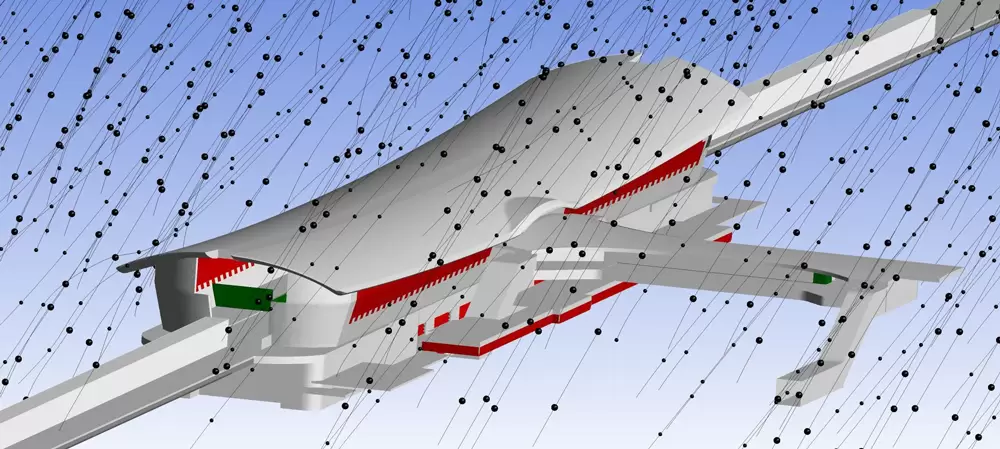Simulation technology for the protection of buildings and infrastructure can be beneficial for the bottom line, can prevent legal issues and might even save lives, writes Dr Jimmy Lea FIEAust CPEng.
The future of engineering is being shaped by rapidly evolving applications of technologies such as machine learning, virtual reality and simulation of synthetic environments. To remain relevant, avoid disruption and constantly innovate, it’s important that engineers adopt such technologies.
Results from modelling and simulation offer greater clarity and therefore create a powerful environment for properly informed decision making. To demonstrate its application, this article outlines two very different uses for modelling and simulation around buildings and infrastructure.
Weather: Wind-driven rain
Many don’t pay a great deal of thought to wind-driven rain (WDR) until they discover their insurance policy doesn’t cover the damage it can cause. Planning for WDR is not just about insurance, though. It’s also about usability, safety and comfort for the users of the building, as well as leasee security.
Consider above-ground railway stations. They are typically designed for natural ventilation to increase user comfort. However, when it rains they can suffer water ingress, affecting staff, customers and business owners.
An approach to minimise, if not prevent, such issues is to use computational fluid dynamics (CFD) modelling and simulation. The objective is to determine the effectiveness of a building’s weather protection features while still maintaining the effectiveness of its natural ventilation capability. Modelling will show where rain can penetrate and how effective louvres might be in keeping rain out while still bringing air in.
Four rain droplet sizes, each with its own terminal velocity and drag coefficient, will be modelled. Prevailing wind in eight directions will be simulated.

The effect of approaching trains will be factored in, as will neighbouring buildings, including the effect of the removal of existing neighbouring buildings. From here, the results from the worst two scenarios can be employed to fine-tune the station’s design.
This can help the design engineer achieve a balance between the ingress of WDR and passenger experience. If conducted during the design phase, it can prevent costly rework of the station.
Human safety: Blast effects analysis
Terrorism has become a concern, particularly in city centres and around government and military buildings. Still, many buildings are constructed based only on building codes that lack design considerations intended to prevent or mitigate impact from an explosive blast.
To enhance a building’s protection features, one approach is to use a conventional table and chart method employing a set of loosely defined measures to estimate blast effects. A second method is to use modelling and simulation technology to accurately predict blast effects.
The table and chart method is designed as a one-size-fits-all, aiming to cover as many building features, sizes, shapes and scenarios as possible. Of course, this may lead to under- or over-estimation. Despite this shortcoming of the table and chart method, it is still useful for providing instant estimations.
On the other hand, the modelling and simulation method offers bespoke assessment specific to a building’s features and to particular scenarios – the location, intensity and duration of the explosive charge, for instance – and therefore delivers more accurate results.
A typical application of this method is the blast effects analysis, which relies on the principle of fluid structure interaction (FSI). FSI involves the study of the interaction between the blast wave and the building structures. Factors such as proximity to neighbouring buildings, building shape, orientation, height, wall thickness, age, and concrete compressive and tensile strengths are factored into the model.
Results will show the degree and location of damage on this and neighbouring buildings, the effects of types of reinforcement in concrete, the value of specific types of hardware such as particular door frames, and what it will take to ensure the safety of those inside.
While the benefits of the modelling and simulation method are obvious, a drawback of this method is that it can take longer to obtain results. Thus, a balanced approach is to combine two methods: the table and chart method is useful for quick, preliminary evaluations and to shortlist the most likely scenarios; the modelling and simulation method can assess those shortlisted scenarios to obtain more accurate results.
By combining the two methods, engineers can, within a reasonable time frame, perform blast effects analysis to obtain information around design and cost to protect against a particular level of threat.
What is involved?
Some large firms might want to purchase the modelling software and employ a specialist to run simulation, improve designs and produce reports. Others will likely find it more feasible to outsource as they might only have to run simulations three or four times a year.
A consultant will require two to four weeks to gather the necessary information, develop the 3D model, run the simulation and write up a report.
However it is carried out, modelling and simulation is a powerful investment in a project, with positive outcomes for all stakeholders.
